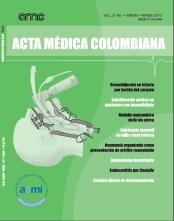Cardiac remodeling in patients with myocardial infarction secondary to penetrating heart wound
Abstract
The mechanism and magnitude of the cardiac remodelling process in traumatic acute myocardial infarction remain unknown.
Objective: to characterize and quantify the process in patients who developed traumatic myocardial infarction secondary to penetrating heart wound, and to compare it with patients without infarction.
Methods: a prospective, observational cohort study was carried out in patients with myocardial infarction secondary to penetrating heart wound. The exposed cohort comprised all patients with traumatic myocardial infarction and the non-exposed cohort comprised the patients without infarction.
Results: there were 31 male patients, two female patients, mean age was 31 years. More than 90 percent of the wounds were caused by a sharp, pointed weapon. At the baseline, the ejection fraction and fractional shortening were significantly lower in the patients with infarction (52% vs 70%, p< 0.0001; 27.6% vs 35.1%, p< 0.001, respectively). At the six-month follow-up, the only variable significantly different between the two groups was the fractional shortening (30.18 vs. 34.72, p < 0.05). Patients with penetrating heart wound and with secondary traumatic AMI have a RR of 2.67 (95% CI 0.72-9.89) of developing eccentric hypertrophy after six months
Conclusions: patients with penetrating heart wounds with and without infarction showed a tendency to develop a remodelling process with eccentric hypertrophy. The differences encountered, however, are not significant and a longer follow-up is required, as well as a larger number of patients
Metrics
Copyright (c) 2019 Juan Manuel Senior,Clara Saldarriaga,Claudia María Navas,Luz Helena Lugo,Sergio Daniel Ortiz,Juan Carlos Parra

This work is licensed under a Creative Commons Attribution 4.0 International License.
Acta Medica Colombiana uses the CC-BY 4.0 license. Authors retain all rights over their work.


